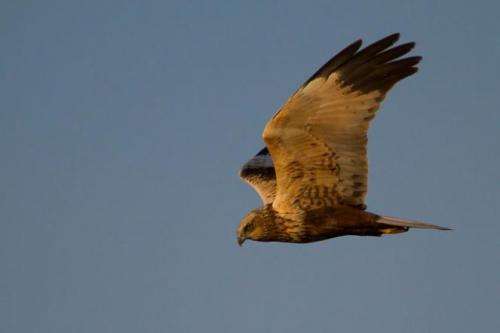New data about marsh harrier distribution in Europe

The use of ringing recoveries —a conventional method used to study bird migration— in combination with more modern techniques such as species distribution modelling and stable isotope analysis helps to understand bird distribution patterns and origin considering place and time of the year. This is the main conclusion of the papers published in the Journal of Ornithology and Diversity and Distributions by a research group led by Dr Santi Mañosa and Dr Laura Cardador.
Both scientific publications—also signed by research teams from the Catalan Ornithological Institute, the Doñana Biological Station and Environment Canada— focus on the study of marsh harriers (Circus aeruginosus), a semi-colonial, ground-nesting raptor that mainly breeds in wetlands.
An endangered raptor species since the 80s
According to Santi Mañosa, "In the Iberian Peninsula, marsh harrier nesting population has increased in the last three decades; it has recovered from the dramatic situation it experienced in the eighties, as a consequence of the use of organochloride insecticides, wetland drainage and hunting." In winter, population increases due to migrant harriers coming from central and northern latitudinal Europe.
These studies analyse the factors that constraint marsh harrier distribution, population (breeding and wintering) superposition, the origin of wintering birds and the requirements of each population fraction. To give an answer to all these questions, traditional techniques (ring recoveries) and more modern ones (species distribution modelling and stable isotope analyses) were combined. All three are fundamental to obtain as much information as possible from the scarce data about birds that are available.
Marsh harrier population constraint goes beyond environmental factors
"Results indicate that current marsh harrier distribution in the Iberian Peninsula is not only limited by environmental variables during the breeding season," explains researcher Laura Cardador. "There are other factors that lead individuals to join other groups (conespecific attraction)," she adds. "These factors —she affirms— slow down the process of expansion and explain, to some extent, species absence in certain wet areas which are apparently suitable for birds."
On the contrary, in winter, distribution is exclusively constrained by climate and environmental factors because migrant harriers occupy preferable the areas with better climate conditions, independently of localization. Particularly, they occupy some eastern Mediterranean coastal areas where the species has not bred for more than a decade. "Data obtained from ring recoveries and stable isotope analyses confirm that most marsh harriers wintering in the Iberian Peninsula are migrant birds from central and northern Europe and only some of them are resident birds. The geographical origin of individuals varies according to the wintering area," explain authors.
Results prove that bird populations that inhabit the Iberian Peninsula during the wintering season are exposed to different ecological conditions depending on their origin. These studies contribute to understand better why different populations —which seem to be exposed to the same conditions at their origin— show different trends and conservation status due only to their segregation at wintering areas.
Moreover, both studies also prove that ring recoveries continue to be an effective tool to analyse the information obtained by using more modern techniques. According to Santi Mañosa and Laura Cardador, "in short, this multidisciplinary approach enables us to get a more integrated view of ecology and bird conservation problems in Europe."
More information: Laura Cardador, Francesc Sardà Palomera, Martina Carrete, Santi Mañosa. "Incorporating spatial constraints in different periods of the annual cycle improves species distribution model performance for a highly mobile bird species". Diversity and Distributions, 20(5):515-528. DOI: 10.1111/ddi.12156
Laura Cardador, Joan Navarro, Manuela G. Forero, Keith A. Hobson, Santi Mañosa. "Breeding origin and spatial distribution of migrant and resident harriers in a Mediterranean wintering area: insights from isotopic analyses, ring recoveries and species distribution modelling." Journal of Ornithology. DOI: 10.1007/s10336-014-1122-0
Journal information: Diversity and Distributions
Provided by University of Barcelona

















